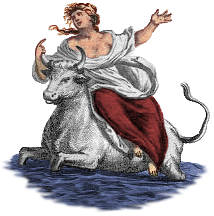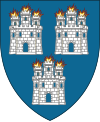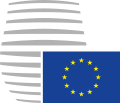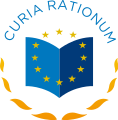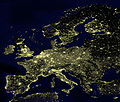
Back بوابة:الاتحاد الأوروبي Arabic Portal:Avropa İttifaqı Azerbaijani প্রবেশদ্বার:ইউরোপীয় ইউনিয়ন Bengali/Bangla Portal:Unió Europea Catalan Portál:Evropská unie Czech Portal:Den Europæiske Union Danish Portal:Europäische Union German Πύλη:Ευρωπαϊκή Ένωση Greek Portal:Unión Europea Spanish Teemasivu:Euroopan unioni Finnish
Introduction
The European Union (EU) is a supranational political and economic union of 27 member states that are located primarily in Europe. The Union has a total area of 4,233,255 km2 (1,634,469 sq mi) and an estimated total population of over 448 million. The EU has often been described as a sui generis political entity (without precedent or comparison) combining the characteristics of both a federation and a confederation. Containing 5.8% of the world population in 2020, EU member states generated a nominal gross domestic product (GDP) of around US$16.6 trillion in 2022, constituting approximately one sixth of global nominal GDP. Additionally, all EU states except Bulgaria have a very high Human Development Index according to the United Nations Development Programme. Its cornerstone, the Customs Union, paved the way to establishing an internal single market based on standardised legal framework and legislation that applies in all member states in those matters, and only those matters, where the states have agreed to act as one. EU policies aim to ensure the free movement of people, goods, services and capital within the internal market; enact legislation in justice and home affairs; and maintain common policies on trade, agriculture, fisheries and regional development. Passport controls have been abolished for travel within the Schengen Area. The eurozone is a group composed of the 20 EU member states that have fully implemented the economic and monetary union and use the euro currency. Through the Common Foreign and Security Policy, the union has developed a role in external relations and defence. It maintains permanent diplomatic missions throughout the world and represents itself at the United Nations, the World Trade Organization, the G7 and the G20. Due to its global influence, the European Union has been described by some scholars as an emerging superpower. In 2012, the EU was awarded the Nobel Peace Prize. The United Kingdom became the only member state to leave the EU, in 2020; ten countries are aspiring or negotiating to join it. (Full article...) Selected article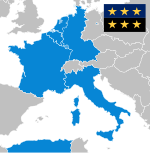 The ECSC was first proposed by French foreign minister Robert Schuman on 9 May 1950 as a way to prevent further war between France and Germany. He declared his aim was to 'make war not only unthinkable but materially impossible.' The means to do so, Europe's first supranational Community, was formally established in 1951 by the Treaty of Paris, signed not only by France and West Germany, but also by Italy and the three Benelux states: Belgium, Luxembourg and the Netherlands. Between these states the ECSC would create a common market for coal and steel. The ECSC was governed by a 'High Authority', checked by bodies representing governments, MPs and an independent judiciary. The ECSC was joined by two other similar communities in 1957, with whom it shared its membership and some institutions. In 1969 all its institutions were merged with that of the European Economic Community (EEC, which later became part of the European Union), but it retained its own independent identity. However in 2002 the Treaty of Paris expired, and with no desire to renew the treaty, all the ECSC activities and resources were absorbed by the European Community. During its existence, the ECSC had succeeded in creating a common market but could not prevent the decline of the coal and steel industries. It did however set the ground for the future European Union. Selected picturePainting: František Kupka The Cathedral is an abstract oil painting on canvas created by Czech artist František Kupka in 1912–1913. Measuring 180 by 150 centimetres (71 in × 59 in), the painting is held by the Museum Kampa in Prague, Czech Republic. In this painting, vertical lines running the entire length of the canvas are intersected by diagonal lines to form rectilinear shapes of various sizes and colors.
Did you know?... that the presidency of the EU Council rotates every half year? ... that the EU parliamentary election is the world's biggest transnational election? ... that the European Union was awarded the Nobel Peace Prize in 2012? Selected cityDublin is the capital and the largest city of the Republic of Ireland, located near the midpoint of Ireland's east coast, at the mouth of the River Liffey and forms the centre of the Dublin Region. Originally founded as a centre of Viking settlement, the city has been Ireland's capital city since mediæval times. The population within the city was 505,739 at the census of 2006. Beyond this, at the same census the Dublin Region population was 1,186,159, whilst the Greater Dublin Area had a figure of 1,661,185. In a 2003 European wide survey by the BBC, questioning 11,200 residents of 112 urban and rural areas, Dublin was found to be the best capital city in Europe to live in, and the Republic of Ireland was judged to be the most content country in Europe. A person from Dublin is known as a Dubliner or colloquially as a Dub. Dublin is a major European cultural centre and the origin of many prominent literary figures including Jonathan Swift, Bram Stoker, Oscar Wilde, William Butler Yeats, James Joyce, George Bernard Shaw, Seán O'Casey, and Samuel Beckett. General imagesThe following are images from various European Union-related articles on Wikipedia.
TopicsFeatured contentFeatured articles
Featured lists
Featured contentGood articles
CategoriesRelated portalsAssociated WikimediaThe following Wikimedia Foundation sister projects provide more on this subject:
Discover Wikipedia using portals |
© MMXXIII Rich X Search. We shall prevail. All rights reserved. Rich X Search


